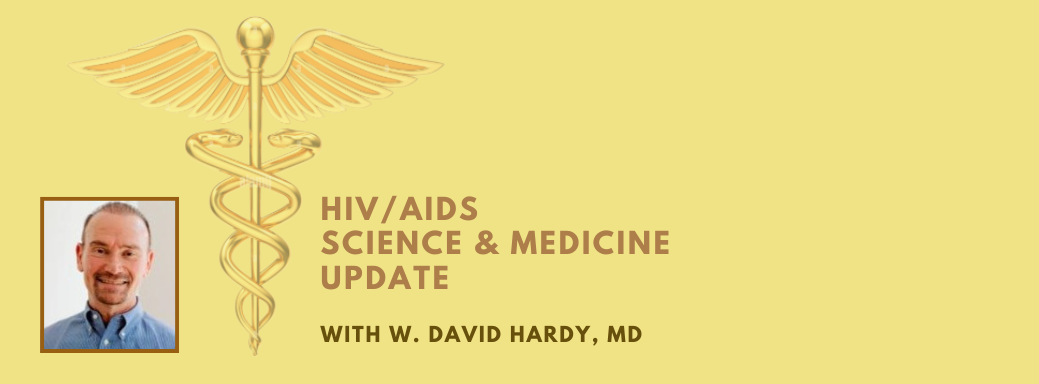
Initiative for Ending the HIV Epidemic in the U.S.
By W. David Hardy, M.D.
Most Americans are probably not aware of the initiative, Ending the HIV Epidemic (EHE): A Plan for America, announced by the US government in 2019.
The initiative is aimed at finally addressing the HIV epidemic in the United States on a national level. This is the first time that a comprehensive, well-organized plan has been created, and most critically, funded, by the federal government to implement the proven, highly effective tools of HIV testing, antiretroviral treatment and PrEP to stop the continued transmission and life-threatening impact of HIV in our country.
The U.S. is unique in that it has had a federal policy-making office (Office for National AIDS Policy, ONAP) since 2010, BUT no specific and funded implementation plan for addressing the HIV epidemic. Ironically, the U.S. requires fundees of the President’s Emergency Plan for AIDS Relief (PEPFAR) in Africa and other parts of the world to have such an implementation plan as a condition for receiving financial support, but until 2019 didn’t have its own such plan.
Perhaps one of the biggest reasons for this lack of awareness is that, paradoxically, the initiative was first announced by former President Trump during his State of the Union address in February 2019.
Yes, this is the same former President who vehemently opposed and tried to overturn the Affordable Care Act (ACA), including Medicaid Expansion on which this initiative depends.
The genesis of this initiative was the brainchild of Dr. Tony Fauci at the National Institutes of Health (NIH) and Dr. Robert Redfield, former Director of the Centers for Disease Control and Prevention (CDC). They proposed their idea to create, fund and implement nationwide HIV testing, antiretroviral treatment and PrEP to Trump and, curiously, he agreed.
The goals of the EHE are lofty. It aims to reduce the number of new persons in the US diagnosed with HIV infection by 75% by 2025 and by 90% by 2030.
Putting this into real numbers, in 2019, the CDC reported 38,801 new persons diagnosed with HIV. If successful, this initiative would reduce that number to 9,588 by 2025 and to 3,000 by 2030.
The number of new HIV infections in the U.S. has not been this low since 1981 when AIDS was first identified.
The EHE is built on four “pillars”: Diagnose, Treat, Prevent, and Respond (see graphic above).
During the first three years, the initiative is focusing on the 48 counties in the U.S. with the highest number of new HIV diagnoses in 2016 and 2017, as well as San Juan, Puerto Rico, and Washington D.C. It also focuses on seven states with a substantial rural burden of new HIV diagnoses.
More than 50% of new HIV diagnoses in the U.S. occur in these 48 counties, D.C., and San Juan. Following implementation in these areas, the initiative will have a broader reach, extending to the nation as a whole.
Most importantly, the commitment to ending the HIV epidemic in the U.S. has been accompanied by new federal funding, starting in 2019, which consisted of a small number of grants to launch the initiative prior to its formal start in 2020. In his 2020 budget request, President Trump asked for $291 million in new funding for the EHE and Congress provided $271 million.
This represented the first significant funding increases in many years for HIV prevention at the CDC and for the Ryan White HIV/AIDS Program, the nation’s safety net program for HIV care and treatment. Funding in 2020 was also provided to the NIH Office of AIDS Research (OAR).
President Biden’s 2021 budget request to Congress included $716 million for the EHE, which represented an increase of $450 million over the 2020 budget. Congress approved $404.75 million for 2021, including increased funding for the CDC, Ryan White HIV/AIDS Care Program, Community Health Centers (which provide HIV testing, treatment, and PrEP), Rural Health Centers, the NIH, and the Indian Health Service.
For his 2022 budget request for the EHE, President Biden has requested a total of $670 million, which represents an increase of $265 million over the 2021 budget.
This initiative has a significant amount of work ahead of it. This graph demonstrates the most recent information on the current status of HIV care, engagement in treatment and viral suppression among persons with HIV in the U.S.
The EHE involves all currently active HIV testing, medical care, PrEP care and research divisions of the Department of Health and Human Services (DHHS), including the CDC, the Health Resources and Services Administration (HRSA), including the Ryan White AIDS Care Program, federally-funded Community Health Centers both urban and rural, the NIH and the Indian Health Services.
It is planned that through expanding the currently-available HIV testing, providing treatment and PrEP services, based on individually-funded counties or cities, programs will be able to address, on a local, community-based level how best to achieve the initiative’s goals.
Just as the EHE was rolling out in 2020, the COVID-19 Pandemic hit the US. Many of the funded and to-be-funded counties and cities had to put their plans on hold due to the many local community shutdowns. As the pandemic has lessened in some communities, planning committees are revising their roll-out plans and beginning to implement these plans.
The Biden Administration has committed to incrementally increasing funding for this initiative, has re-activated the President’s Advisory Committee on HIV/AIDS as well as ONAP, both of which were disbanded under Trump. Optimism is high that the EHE will be successful in achieving its feasible goals and help the US move out of last position and catch up with the rest of the high-income countries of the world.
David Hardy, MD, is an Adjunct Clinical Professor of Medicine at the Keck School of Medicine of USC and a FAM Board Member.